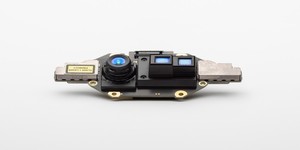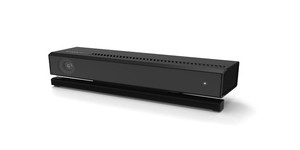
Microsoft has formally unveiled the Kinect for Windows v2 hardware, based on the updated Kinect depth-sensing camera system developed for the Xbox One console.
Like its predecessor, the Kinect for Windows v2 will officially only support Microsoft's own operating system - although it didn't take long for hackers and tinkerers to get its predecessor running on rival platforms - and come complete with a software development kit for coders who want to add support for the tracking technology to their own products.
The design of the Kinect hardware has changed little from its Xbox One incarnation, aside from Microsoft replacing the Xbox logo from the top-left of the panel with a more platform-neutral Kinect version. The power indicator, previously a glowing-green X shape, has also been revised a subtle single LED.
The Kinect for Windows v2 isn't purely plug-and-play, however: while the Xbox One version works with but a single cable, its Windows variant needs a couple of extra boxes which come bundled. The first is a power supply, suitable for international use and accepting a laptop-style figure-eight cable; the second is a separate hub box, which takes power from the PSU and accepts a USB 3.0 connection to the host PC. A single cable combining both data and power then leads to the sensor unit itself.
The Windows port of Kinect v2 is expected to include all the functionality of its Xbox One cousin, including the ability to track a user's heartbeat by looking for micro-fluctuations in skin tone caused by the pumping of blood. Its specifications suggest, however, that it will require a USB 3.0 port to operate - an indication of the increased data traffic caused by the higher-resolution sensors.
Microsoft has not yet provided a release date or pricing information for Kinect for Windows v2.
Like its predecessor, the Kinect for Windows v2 will officially only support Microsoft's own operating system - although it didn't take long for hackers and tinkerers to get its predecessor running on rival platforms - and come complete with a software development kit for coders who want to add support for the tracking technology to their own products.
The design of the Kinect hardware has changed little from its Xbox One incarnation, aside from Microsoft replacing the Xbox logo from the top-left of the panel with a more platform-neutral Kinect version. The power indicator, previously a glowing-green X shape, has also been revised a subtle single LED.
The Kinect for Windows v2 isn't purely plug-and-play, however: while the Xbox One version works with but a single cable, its Windows variant needs a couple of extra boxes which come bundled. The first is a power supply, suitable for international use and accepting a laptop-style figure-eight cable; the second is a separate hub box, which takes power from the PSU and accepts a USB 3.0 connection to the host PC. A single cable combining both data and power then leads to the sensor unit itself.
The Windows port of Kinect v2 is expected to include all the functionality of its Xbox One cousin, including the ability to track a user's heartbeat by looking for micro-fluctuations in skin tone caused by the pumping of blood. Its specifications suggest, however, that it will require a USB 3.0 port to operate - an indication of the increased data traffic caused by the higher-resolution sensors.
Microsoft has not yet provided a release date or pricing information for Kinect for Windows v2.

MSI MPG Velox 100R Chassis Review
October 14 2021 | 15:04








Want to comment? Please log in.